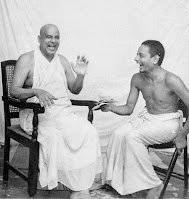Pages
COACHING - COURSES
Pages
Saturday, December 25, 2021
The acceptance of pain the door to true happiness and peace ~ Nisargadatta
The acceptance of pain the door to true happiness and peace
Acceptance of pain takes you much deeper than pleasure does.
The personal self by its very nature is constantly pursuing pleasure and avoiding pain. The ending of this pattern is the ending of the self.
The ending of the self with its desires and fears enables you to return to your real nature, the source of all happiness and peace.
Sunday, December 12, 2021
OM! The Cause Of Bondage is Raga-Dvesha. ~ Swami Sivananda
The Cause Of Bondage is Raga-Dvesha!
Raga-Dvesha is translated as like-dislike or attraction-repulsion or love-hatred.
Raga (attraction), Dvesha (repulsion) and Tatastha Vritti (indifference) are the three important modifications of the mind (Vrittis).
Raga and Dvesha (like and dislike or love and hatred or attraction and repulsion) are the two currents in the mind which bind a man to the Samsaric wheel of birth and death.
Raga and Dvesha are the two Doshas or faults in the mind that have brought you to this world. Bondage. (Svarupa of Bandha) is Raga and Dvesha. The Svarupa of Ajnana is Raga and Dvesha. All the emotions come under the category of Raga-Dvesha. These two currents are the Dharma (characteristics) of the mind and not of the spirit.
Pleasure and pain, exhilaration and depression (Harsha and Soka), are due to Raga-Dvesha.
If Raga and Dvesha vanish from the mind, Harsha-Soka also will disappear.
It is desire that sets the mind in motion. When there is a desire, Raga and Dvesha (like and dislike or love and hatred or attraction and repulsion) exist side by side in the mind. Desire is a motive force. Emotions and impulses co-exist with desire.
Whenever there is pleasure and Raga, there exist side by side fear and anger. Anger is only a modification of desire. Fear and anger are two old associates of pleasure and Raga.Fear and anger are hidden in Raga. They constantly torment the mind.
Fear is hidden in Raga. When you have got Raga for body, fear of death comes in. When you have Raga for money, there is fear of losing money, as money is the means of getting objects of enjoyment. When you have Raga for a woman, you always take care in protecting her. Fear is a very old, intimate friend of Raga.
From ignorance (Avidya) emanates non-discrimination (Aviveka).
From non-discrimination (Aviveka) originates Ego (Ahankara) and clinging or identification with the body.(Abhimana). F
rom Abhimana emanates Attraction-Repulsion (Raga-Dvesha).
From Raga-Dvesha comes action ( Karma).
From Karma comes the body. From body comes misery.
This is the chain of bondage and misery with seven links.
If you do not want misery, do not take up the body.
If you do not want body, do not do (actions) Karma.
If you do not want to do Karma, give up attraction-repulsion (Raga-Dvesha).
If you want to give up Raga-Dvesha, give up attachment to the body (Abhimana).
If you want to give up Abhimana, give up non-discrimination ( Aviveka). If you want to give up Aviveka, give up ignorance (Avidya). If you do not want ignorance, get Brahma-Jnana.
This Samsara or world process is kept up by the six-spoked wheel, viz., Attraction ( Raga), Repulsion (Dvesha), merit, demerit, pleasure and pain.
If the root cause, the original Avidya, is destroyed byattainment of knowledge of Brahman (Brahma-Jnana), the whole chain of Abhimana, Raga, Dvesha, Karma, body, merit and demerit, pleasure and pain will vanish.
One link hangs upon another. All the linkswill be broken totally on the advent of Jnana. Sruti says: "Liberation comes from knowledge of Brahman (Rite Jnananna muktih)"
Is there freedom with conditions? Atman Nityananda
Is there freedom with conditions?
When we set conditions for our security, happiness, peace, love and fulfillment (i.e., feeling secure, peaceful, fulfilled, loved and happy when....), then we attach and enslave ourselves to those conditions (objects, things, people or situations) through which we believe we will obtain them (happiness, love, peace, fulfillment, peace, fulfillment). We actually attach to and enslave ourselves to our thoughts, beliefs and feelings about them.
And what does it mean that we are attached and enslaved? That we live in the company of fear and anger, frustration and sadness.
Thursday, December 9, 2021
WHY MEDITATION? - Atman Nityananda
Tuesday, December 7, 2021
Desire and emotions. - Atman Nityananda
Desire and emotions!
Lower emotions are children of desire. Attachment, fear, anger, exhilaration, grief or depression, pleasure and pain, ike dislike, attraction-repulsion, love-hatred, jealousy, greed, vanity, pride all are children of desire.
However, desire is the essential nature of Ego. Hence, all lower emotions are only an expression of the desirous Ego..
Follows extract of Swami Sivananda
Emotions and impulses co-exist with desire.
Desire is a motive force. It is desire that sets the mind in motion.
Emotions are desires which are penetrated by the thought element.
In other words, emotion is desire mingled with thought.
The vibrations of emotions will arouse corresponding excitement in purely mental matter and all the man’s thoughts will be disturbed and distorted.
When there is a desire, Raga and Dvesha (like and dislike or love and hatred or attraction and repulsion) exist side by side in the mind.
It is a symptom of weakness to have emotions in the mind. They should be controlled bythe intellect and the will.
https://www.dlshq.org/download/mind-its-mysteries-and-control/#_VPID_25





